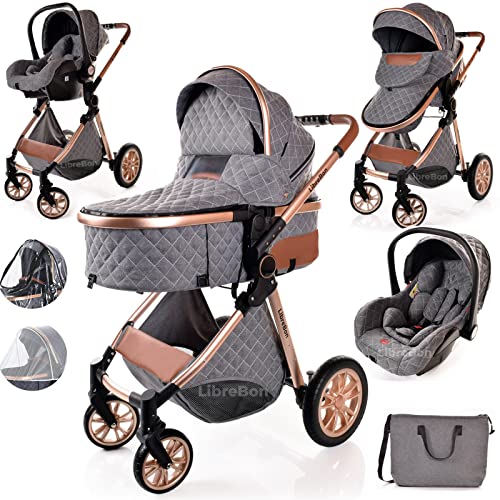Prams and Pushchairs: A Comprehensive Guide for New Parents
Browsing being a parent involves a plethora of choices, among the most significant being the choice of an appropriate pram or pushchair. These necessary products act as a sanctuary for babies and a method of transport for caretakers. Whether strolling through the park or running errands, a good pram or pushchair can boost the experience for both parent and kid. This short article provides an in-depth take a look at the types of prams and pushchairs readily available, their features, and vital considerations to make before acquiring one.
Understanding Prams and Pushchairs
While the terms "pram" and "pushchair" are frequently utilized interchangeably, they refer to slightly different products. Comprehending the difference can help in making an educated choice.
| Term | Description |
|---|---|
| Pram | Usually created for babies, prams have a totally flat structure, enabling the baby to lie down conveniently. They typically come with a carrycot and appropriate for newborns as much as about six months old. |
| Pushchair | Developed for older babies and young children, pushchairs frequently have a more upright seating position. They are versatile and can normally be reclined or gotten used to deal with the kid's development, starting from around 6 months and extending to preschool age. |
Kinds of Prams and Pushchairs
When choosing a pram or pushchair, different designs will deal with various parenting requirements and way of lives. Here are the primary types available on the marketplace:
Traditional Prams
- Timeless, classic designs with a strong carrycot.
- Ideal for newborns.
- Normally bulkier, suitable for leisurely walks.
Pushchairs
- Light-weight and frequently foldable, ideal for travel and fast outings.
- Can be front-facing or rear-facing.
- Consist of functions like adjustable handlebars and reclining seats.
Travel Systems
- A mix of a vehicle seat and a pushchair.
- Convenient for car-to-pushchair transitions without interrupting the baby.
- Usually more pricey but worth thinking about for their multifunctionality.
Multi-Functional Strollers
- Offer different setups, enabling a carrycot, sit-up seat, or car seat attachment.
- Adaptable according to the kid's development and changing needs.
- Can typically be used for numerous children with attachments.
Lightweight Strollers
- Ultra-portable, ideal for parents on the go.
- Easy to fold and carry.
- Usually suggested for older babies or toddlers.
Secret Features to Consider
When selecting the best pram or pushchair, a couple of important features need to be taken into consideration:
Safety Features
- Look for a five-point harness system to protect the child.
- Designs with braking systems that are simple to run with the foot offer added safety.
Weight and Size
- Consider how much weight the caregiver can manage, and the storage area offered.
- A lightweight design might supply simpler maneuverability, while a bulkier design may use much better stability and sturdiness.
Resilience and Material
- A frame made from top quality materials makes sure longevity.
- Weather-resistant fabrics can provide convenience and ease of cleaning.
Alleviate of Folding
- Designs that can be folded rapidly and quickly are typically favored, particularly for moms and dads who require to utilize public transport or have limited storage area.
Handling and Comfort
- Adjustable handles can accommodate various heights, making sure a comfortable push for all caretakers.
- Great suspension is necessary for smoother rides on unequal surface areas.
Getting ready for the Purchase
Before making a purchase, it's advisable to carry out extensive research. The following steps will assist brand-new moms and dads make a notified choice:
Define Your Needs
- Think about way of life factors such as travel frequency, urban vs. rural living, and storage space.
Budgeting
- Prams and pushchairs differ considerably in price. Set an affordable spending plan, keeping in mind safety and quality.
Test Drive
- Whenever possible, test the pram or pushchair. Take note of weight, maneuverability, and overall comfort.
Parent and Baby Reviews
- Search for feedback from other parents who have actually used the item. This can offer insights into real-world performance.
Look for Warranty
- An excellent service warranty can protect your investment and ensure durability.
Frequently asked questions
Q1: At what age can a baby use a pushchair?Typically, babies can
start utilizing a pushchair around six months when they can hold their direct separately. Prior to Small Prams For Newborns , a pram or carrycot is advised. Q2: Are travel systems worth the investment?Yes, travel systems can provide fantastic value for parents who need a seamless shift in between the
automobile and stroller. They supply benefit and versatility, particularly for households who frequently travel. Q3: How long can you use a pushchair?Most pushchairs can be used until a child is around 3 to 4 years of ages, though some designs offer features for bigger children. Q4: Do I require a new pram or pushchair for each child?If your existing model is in excellent condition and satisfies safety standards, there might be no requirement for a brand-new one. Nevertheless, consider factors like wear and tear, health, and developing requirements. Selecting the best pram or pushchair is a crucial decision for any new parent. With a variety of styles, types, and features available, parents can discover a model that fits their requirements, way of life, and budget plan.
By investigating and comprehending the distinctions in between prams and pushchairs, parents can make a positive and educated option that will supply the best, most hassle-free experience for their kid. As they embark on this amazing journey of parenthood, having the best transport option can really boost the experience of raising a child.

